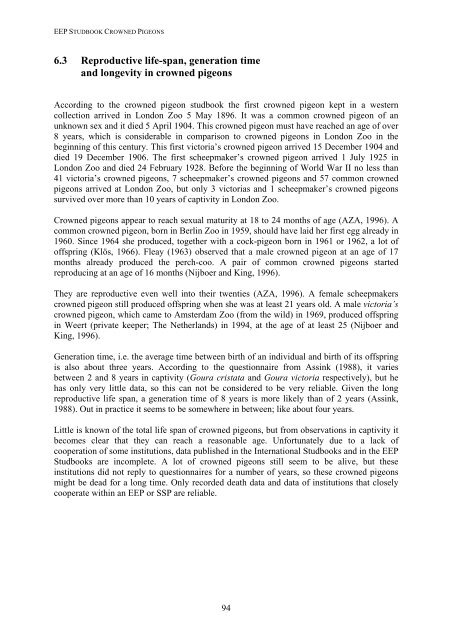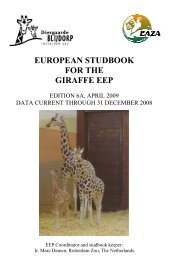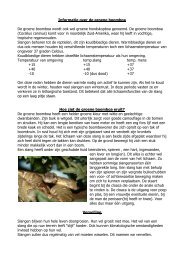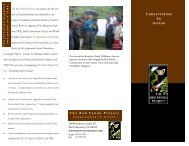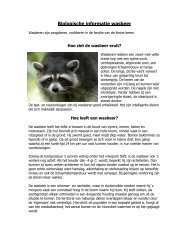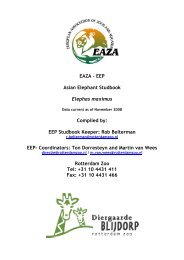You also want an ePaper? Increase the reach of your titles
YUMPU automatically turns print PDFs into web optimized ePapers that Google loves.
<strong>EEP</strong> STUDBOOK CROWNED PIGEONS<br />
6.3 Reproductive life-span, generation time<br />
and longevity in crowned <strong>pigeon</strong>s<br />
According to the crowned <strong>pigeon</strong> studbook the first crowned <strong>pigeon</strong> kept in a western<br />
collection arrived in London Zoo 5 May 1896. It was a common crowned <strong>pigeon</strong> of an<br />
unknown sex and it died 5 April 1904. This crowned <strong>pigeon</strong> must have reached an age of over<br />
8 years, which is considerable in comparison to crowned <strong>pigeon</strong>s in London Zoo in the<br />
beginning of this century. This first victoria’s crowned <strong>pigeon</strong> arrived 15 December 1904 and<br />
died 19 December 1906. The first scheepmaker’s crowned <strong>pigeon</strong> arrived 1 July 1925 in<br />
London Zoo and died 24 February 1928. Before the beginning of World War II no less than<br />
41 victoria’s crowned <strong>pigeon</strong>s, 7 scheepmaker’s crowned <strong>pigeon</strong>s and 57 common crowned<br />
<strong>pigeon</strong>s arrived at London Zoo, but only 3 victorias and 1 scheepmaker’s crowned <strong>pigeon</strong>s<br />
survived over more than 10 years of captivity in London Zoo.<br />
<strong>Crowned</strong> <strong>pigeon</strong>s appear to reach sexual maturity at 18 to 24 months of age (AZA, 1996). A<br />
common crowned <strong>pigeon</strong>, born in Berlin Zoo in 1959, should have laid her first egg already in<br />
1960. Since 1964 she produced, together with a cock-<strong>pigeon</strong> born in 1961 or 1962, a lot of<br />
offspring (Klös, 1966). Fleay (1963) observed that a male crowned <strong>pigeon</strong> at an age of 17<br />
months already produced the perch-coo. A pair of common crowned <strong>pigeon</strong>s started<br />
reproducing at an age of 16 months (Nijboer and King, 1996).<br />
They are reproductive even well into their twenties (AZA, 1996). A female scheepmakers<br />
crowned <strong>pigeon</strong> still produced offspring when she was at least 21 years old. A male victoria’s<br />
crowned <strong>pigeon</strong>, which came to Amsterdam Zoo (from the wild) in 1969, produced offspring<br />
in Weert (private keeper; The Netherlands) in 1994, at the age of at least 25 (Nijboer and<br />
King, 1996).<br />
Generation time, i.e. the average time between birth of an individual and birth of its offspring<br />
is also about three years. According to the questionnaire from Assink (1988), it varies<br />
between 2 and 8 years in captivity (Goura cristata and Goura victoria respectively), but he<br />
has only very little data, so this can not be considered to be very reliable. Given the long<br />
reproductive life span, a generation time of 8 years is more likely than of 2 years (Assink,<br />
1988). Out in practice it seems to be somewhere in between; like about four years.<br />
Little is known of the total life span of crowned <strong>pigeon</strong>s, but from observations in captivity it<br />
becomes clear that they can reach a reasonable age. Unfortunately due to a lack of<br />
cooperation of some institutions, data published in the International Studbooks and in the <strong>EEP</strong><br />
Studbooks are incomplete. A lot of crowned <strong>pigeon</strong>s still seem to be alive, but these<br />
institutions did not reply to questionnaires for a <strong>number</strong> of years, so these crowned <strong>pigeon</strong>s<br />
might be dead for a long time. Only recorded death data and data of institutions that closely<br />
cooperate within an <strong>EEP</strong> or SSP are reliable.<br />
94


